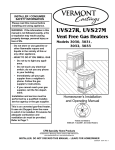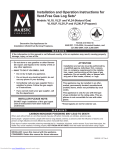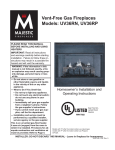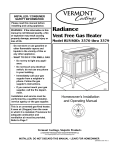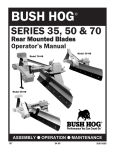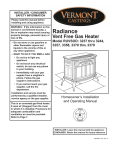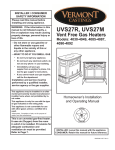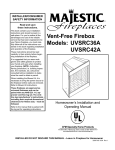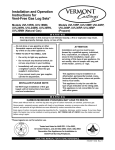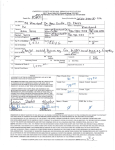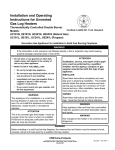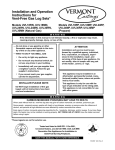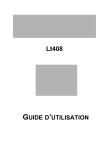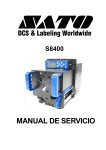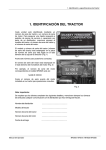Download CFM UVHK23MP User's Manual
Transcript
Installation and Operating Instructions for Gas Log Heaters Models: UVHK23MP, UVHK29MN, UVHK31MP, UVHK36MN Models with “N” after the model number use natural gas; models with “P” after the model number use propane (LP) gas. This appliance operates as an unvented room heater certified under ANSI Z21.11.2b-2004 when fitted to a solid fuel burning masonry or factory built fireplace with the flue damper closed. It also operates as a decorative appliance under ANSI Z21.60b-2001. CSA 2.26b-2001, when fitted to a solid fuel burning masonry or factory built fireplace with the flue damper open. When used as a decorative appliance, the use of a thermostat is not allowed. State or local codes may only allow operation of this appliance in a vented configuration. Check your state or local codes. Split Bark Logs Charred Oak Logs WARNING If the information in this manual is not followed exactly, a fire or explosion may result causing property damage, personal injury or loss of life. FOR YOUR SAFETY — Do not store or use gasoline or other flammable vapors and liquids in the vicinity of this or any other appliance. • • • WHAT TO DO IF YOU SMELL GAS Do not try to light any appliance. Do not touch any electric switch; do not use any phone in your building. Immediately call your gas supplier from a neighbor’s phone. Follow the gas supplier’s instructions. If you cannot reach your gas supplier, call the fire department. • —Installation and service must be performed by a qualified installer, service agency or the gas supplier. This is an unvented gas-fired heater. It uses air (oxygen) from the room in which it is installed. Provisions for adequate combustion and ventilation air must be provided. Refer to Section Provisions For Adequate Combustion and Ventilation Air - Page 6. This appliance may be installed in an aftermarket, permanently located, manufactured (mobile) home, where not prohibited by local codes. This appliance is only for use with the type of gas indicated on the rating plate. This appliance is not convertible for use with other gases. INSTALLER: Leave this manual with the appliance. CONSUMER: Retain this manual for future reference. 20008056 1/07 Rev. 2 Table of Contents Important Information .................................................................................................................. 3 Important Safeguards ............................................................................................................... 4 Installation Requirements ......................................................................................................... 5 High Elevations ......................................................................................................................... 5 Pressure Test Points ................................................................................................................. 5 Odor During Operation .............................................................................................................. 5 Provisions For Adequate Combustion Air ................................................................................. 7 Installation Unpacking ................................................................................................................................. 9 Fireplace Preparation ................................................................................................................ 9 Location .................................................................................................................................... 9 Clearances ................................................................................................................................ 9 Gas Connection ...................................................................................................................... 11 Typical Gas Line Connection .................................................................................................. 11 Gas Line Pipe Sizing ............................................................................................................... 12 Gas Pressure Check ............................................................................................................... 12 Lighting Instructions ................................................................................................................ 13 Turning Off Gas to Appliance .................................................................................................. 13 Match Lighting ......................................................................................................................... 13 Flame Check ........................................................................................................................... 14 Managing Heat Output ............................................................................................................ 14 Maintenance Cleaning .................................................................................................................................. 14 Positioning Logs ...................................................................................................................... 15 Fireplace Screen ..................................................................................................................... 15 Decorative Volcanic Ash ......................................................................................................... 15 Servicing ..................................................................................................................................... 18 Repair Parts ................................................................................................................................ 18 Warranty ..................................................................................................................................... 19 2 20008056 Important Information WARNING: Any change to this heater or its controls can be dangerous. In the Commonwealth of Massachusetts, all gas fitting and installation of this heater shall only be done by a licensed gas fitter or licensed plumber. • Due to high temperatures, the appliance should be located out of traffic and away from furniture and draperies. • The appliance area must be kept clear and free from combustible materials, gasoline and other flammable vapors and liquids. • Children and adults should be alerted to the hazard of high surface temperatures and should stay away to avoid burns or clothing ignition. • Installation and repair must be done by a qualified service person or gas appliance installer. • The appliance must be inspected before use and at least annually by a professional service person. More frequent cleaning may be required due to excessive lint from carpeting, bedding material, dust and pet hair, etc. It is important that the control compartment, burners and circulating air passageways of the appliance be kept clean. • DO NOT place clothing or other flammable material on or near the appliance. • This appliance must only be used with pressures at the inlet as shown in Table 1, Page 12. • The installation must conform with local codes or, in the absence of local codes, with the NATIONAL FUEL GAS CODE, ANSI Z223.1/NFPA 54, latest edition. • Any safety screen or guard removed for servicing an appliance must be replaced prior to operating the heater. • The appliance and its appliance main gas valve must be disconnected from the gas supply piping system during any pressure testing of that system at test pressures in excess of 1/2 PSIG (3.5 kpa). • The appliance must be isolated from the gas supply piping system by closing its equipment shut-off valve during any testing of the gas supply piping system at test pressures equal to or less than 1/2 PSIG. • DO NOT use this heater in recreational vehicles, bedrooms or bathrooms. • If this is the ONLY gas appliance, we recommend a minimum 200 pound cylinder with a fill gauge. Use of a 100 pound cylinder is not recommended. Other household gas appliances may require the tank size to be larger. Do not operate the vent-free heater if the fuel level in the propane tank is below 1/4 full. Use only with two-stage regulator. • DO NOT use this heater if any part of it has been under water. Immediately call a qualified technician to inspect the appliance and replace any part of the control system and any gas control which has been under water. • Any outside air ducts in the fireplace shall be permanently closed at the time of appliance installation. • Check local, state or city codes to determine if unvented heaters are permitted. If unvented heaters are not permitted, the fireplace chimney damper must be fixed at a minimum dimension of 34 sq. inches. This must be accomplished by a clamp or screw on the chimney damper 20008056 to stop at the minimum vent area. The fireplace must also have a minimum vent opening of 34 sq. ins., (Fig. 1) • This appliance may be installed in an after-market* manufactured “mobile” home where not prohibited by state or local codes. • OUTSIDE AIR DAMPER OR ASH DUMP (IF PRESENT) MUST BE CLOSED AND SEALED. • Young children should be carefully supervised when they are in the same room with the appliance. • An unvented room heater having an input rating of more than 10,000 btu per hour shall not be installed in a bedroom or bathroom. • Keep the burner and control compartment clean. See maintenance instructions in this manual. • Never use the heater at a setting between the positions shown on the control knob as this can result in improper combustion and excessive carbon monoxide emissions. • The appliance must be operated with glass doors fully open. • DO NOT operate ceiling fan in room or area with logs when logs are on. • Solid fuels (i.e. wood, paper, trash) shall not be burned in a masonry or UL 127 factory-built fireplace in which an unvented room heater is installed. *After-market: Completion of sale, not for purpose of re-sale from the manufacturer. WARNING: This appliance is for installation only in a solid-fuel burning masonry or UL 127 factory-built fireplace or in a listed ventless firebox enclosure. It has been designed certified for these installations. Exception: DO NOT install this appliance in a factory-built fireplace that includes instructions stating it has not been tested or should not be used with unvented gas logs. WARNING: Do not allow fans to blow directly into the fireplace. Avoid any drafts that alter burner flame patterns. WARNING: Do not use a blower insert, heat exchanger insert or other accessory not approved for use with this heater. Proposition 65 Warning: Fuels used in gas, woodburning or oil fired appliances, and the products of combustion of such fuels, contain chemicals known to the State of California to cause cancer, birth defects and other reproductive harm. California Health & Safety Code Sec. 25249.6 3 WARNING: If the area in which the heater may be operated is smaller than that defined as an unconfined space or if the building is of unusually tight construction, provide adequate combustion and ventilation air by one of the methods described in the National Fuel Gas code, ANSI Z223.1/NFPA 54, Section 5.3, (or applicable local codes). WARNING: During manufacturing, fabricating and shipping, various components of this appliance are treated with certain oils, films or bonding agents. These chemicals are not harmful but may produce annoying smoke and smells as they are burned off during the initial operation of the appliance, possibly causing headaches and eye/lung irritation. This is a normal and temporary occurrence. The National Fuel Gas Code, ANSI Z223.1/NFPA 54 defines a confined space as a space whose volume is less than 50 cubic feet per 1,000 Btu per hour (4.8m3 per kw) of the aggregate input rating of all appliances installed in that space and an unconfined space as a space whose volume is not less than 50 cubic feet per 1,000 Btu per hour (4.8 m3 per kw) of the aggregate input rating of all appliances installed in that space. Rooms communicating directly with the space in which the appliances are installed, through openings not furnished with doors, are considered a part of the unconfined space. Important Safeguards Although your gas logs are very realistic in appearance, it is not a real wood-burning fireplace and must not be used for burning rejected material. To avoid irreparable damage to the appliance or personal injury; matches, paper, garbage or any other material must not be placed or thrown on top of the logs or into the flames. To avoid personal injury, do not touch hot surfaces when the appliance is operating. Touch only the piezo button and control knob. Avoid contact with the front screen, canopy or any other part which will be very hot. Always ensure that the fireplace screen is in place when the appliance is operating and, unless other provisions for combustion air are provided, the screen shall have opening(s) for introduction of combustion air. Close supervision is necessary when the appliance is being operated near children. Do not use to cook food. If this is the ONLY gas appliance, we recommend a minimum 200 pound cylinder with a fill gauge. Use of a 100 pound cylinder is not recommended. Other household gas appliances may require the tank size to be larger. Do not operate the vent free fireplace if the fuel level in the propane tank is below 1/4 full. 4 WARNING: The glowing ember base and all the logs are manufactured from bonded ceramic fiber. This is a commonly used material in industry worldwide. In the event of the logs and base being removed, care should be taken not to damage the bonded material. Intentional misuse of, or deliberately fragmenting, the material could lead to inhaling fibers and be injurious to health. This appliance is intended to be used only for supplemental heat. Do not use it routinely as a primary heat source. Continuous operation could produce excessive humidity depending on construction characteristics and outdoor temperatures (below 20°F). Over time, this could cause condensation to form and damage wall structures and exterior paint. WARNING: Failure to keep primary air opening(s) of the burner(s) clean may result in sooting and property damage. 20008056 Installation Requirements The fireplace must meet the minimum dimensions listed below. (Fig. 1) Do not install the logset if the fireplace does not meet these minimums. Logset Gas UVHK36MN Natural UVHK31MP Propane UVHK29MN Natural UVHK23MP Propane Min. Fireplace Dimensions A B C D Front Rear Overall Overall Width Width Depth Height 28” 18” 14¹⁄₂” 17” 28” 18” 14¹⁄₂” 17” 17” 23” 16” 14¹⁄₂” 23” 16” 14¹⁄₂” 17” Inlet Supply Pressure (w.c.) Min. Max. 5.5” 14.0” 11.0” 14.0” 5.5” 14.0” 11.0” 14.0” Manifold Pressure 3.5” 11.0” 3.5” 11.0” Low Input 10,000 10,000 16,000 14,000 BTU/hr. Med. Input 22,500 20,000 --- High Air Shutter Input Setting 36,000 .136” (1) 31,000 .136” (2) 29,000 .136” (1) 23,000 .136” (2) Pressure Test Points The gas control is equipped with a captured screw-type pressure test point, therefore it is not necessary to provide a 1/8” test point upstream of the control. D Odor During Operation B C A A. Front width C. Depth B. Rear width D.FD370-2 Height FD370-2 Fireplace dimensions/vl18 3/25/99 High Elevations Fig. 1 Minimum fireplace dimensions. Input ratings are shown in BTU per hour and are certified without deration from elevations up to 4,500 feet (1,370m) above sea level. Nuisance outages may occur at altitudes above 4,500 feet (1,370m) if dirt, dust, lint and/or cobwebs are allowed to accumulate on burner and/or ODS pilot. Monthly inspection and cleaning is recommended for altitudes above 4,500 feet (1,370m) For elevations above 4,500 feet (1,370m) in USA, installations must be in accordance with the current ANSI Z223.1/NFPA 54 and/or local codes having jurisdiction. In Canada, please consult provincial and/or local authorities having jurisdiction for installations at elevations above 4,500 feet (1,370m) 20008056 Neither natural gas nor propane gas give off an odor when burned. The nature of a vent free combustion system, however, is such that odors may occasionally be produced during heater operation when impurities exist in the immediate area. Cleaning solutions, paint, solvents, cigarette smoke, candles, adhesives, new carpet or textiles, etc., all can create fumes. These fumes may mix with combustion air and can create odor. Such odors will disappear over time, however, the condition can be alleviated by opening a window or otherwise providing additional ventilation to the area. WARNING This appliance is for installation in a solid-fuel burning masonry, fireplace with a working flue, a U.L.-127 listed manufactured solid-fuel burning fireplace, in any Majestic ventless firebox, or in any listed ventless firebox enclosure certified to I.A.S. U.S. Requirement 2-97 or ANSI Z21.91. NOTICE This is an unvented gas-fired heater. It uses air (oxygen) from the room in which it is installed. Provisions for adequate combustion and ventilation air must be provided. Refer to Pages 7 and 8. 5 Model Wood Burning Fireplace Series BR/BC36, BR/BC36i SHR36 BR/BC42, BR/BC42i SHR42A/48/52 Vent Free Fireplace Series UVDC36, UVDR36 UV36 UVDC42, UVDR42 UVSRC36A UVSRC42A Log Usage Chart CVLS18 SLS18 CVLS24 SLS24 CVLS30 SLS30 UVHK36MN ★ ★ X X UVHK36MN X ★ X X X UVHK36MN X X X X UVHK31MP ★ ★ X X UVHK31MP X ★ X X X UVHK31MP X X X X UVHK29MN X X X X UVHK29MN X X X X X UVHK29MN X X X X - UVHK23MP X X X X UVHK23MP X X X X X UVHK23MP X X X X - ★ with SLS24 and CVLS24 ONLY WARNING: Refer to the above table to ensure that your log set is certified to be used in the CFM Corporation Vent-Free firebox you have purchased. BR/BC and SHR models are designed as wood/solid fuel fireplaces. These wood-burning models must be installed as a wood-burning unit including chimney and termination cap before the installation of the vent-free logs. 6 20008056 Provisions for Adequate Combustion and Ventilation Air WARNING: This heater shall not be installed in a confined space or unusually tight construction unless provisions are provided for adequate combustion and ventilation air. Today’s homes are built more energy efficient than ever. New materials, increased insulation and new construction methods help reduce heat loss in homes. Home owners weather strip and caulk around windows and doors to keep the cold air out and the warm air in. During heating months, home owners want their homes as airtight as possible. While it is good to make your home energy efficient, you need fresh air. All fuel-burning appliances need fresh air for proper combustion. Supplying Adequate Ventilation This appliance must be installed in an unconfined space. The following information will help you classify your space and provide adequate ventilation for complete combustion. An Unconfined Space has a minimum volume of 50 cubic feet for each 1000 BTU/Hr input rating of all appliances in the space. (4.8 M3 per kw), (cubic feet equals length x width x height of space). A Confined Space has a volume of less than 50 cubic feet for each 1000 BTU/Hr input rating of all appliances in the space, (4.8M3 per kw), (cubic feet equals length x width x height of space). Determining if You Have a Confined or Unconfined Space Use this worksheet to determine if you have a confined or unconfined space. Space: Includes the room in which you will install heater plus any adjoining rooms with doorless passageways or ventilation grills between the rooms. 1. Determine the volume of the space (length x width x height). Length x Width x Height = _____cu. ft. (volume of space) Example: Space size 25’ (length) x 25’ (width) x 8’ (ceiling height) = 5,000 cu. ft. (volume of space) If additional ventilation from adjoining room(s) is supplied with grills or doorless openings, add the volume of these rooms to compute the total volume of the applicable space. 2. Divide the space volume by 50 cubic feet to determine the maximum BTU/Hr the space can support. ________(volume of space) ÷ 50 cu. ft. = (Maximum BTU/ Hr the space can support. Example: 5,000 cu. ft. (volume of space) ÷ 50 cu. ft. = 100 or 100,000 (maximum BTU/Hr the space can support) 3. Add the BTU/Hr of all gas burning appliances in the space. Gas range BTU/Hr Vented gas heater BTU/Hr Gas fireplace logs BTU/Hr Other gas appliances* + BTU/Hr Total = BTU/Hr Example: Gas range 60,000 BTU/Hr Vent-free logs + 29,000 BTU/Hr Total = 89,000 BTU/Hr *Do not include direct-vent gas appliances. Direct-vent draws combustion air from the outdoors and vents to the outdoors. 20008056 4. Compare the maximum BTU/Hr the space can support with the actual amount of BTU/Hr used. __________ BTU/Hr (maximum the space can support) __________ BTU/Hr (actual amount of BTU/Hr used) Example: 100,000 BTU/Hr (max. the space can support) 89,000 BTU/Hr (actual amount of BTU/Hr used) The space in the above example is an unconfined space because the actual BTU/Hr used is less than the maximum BTU/Hr the space can support. If the space had been confined, your options would be as follows: A. Rework worksheet, adding the space of an adjoining room. If the extra space provides an unconfined space, remove door to adjoining room or add ventilation grills between rooms. See Ventilation Air From Inside Building. B. Install a lower BTU/Hr heater, if lower BTU/Hr size makes room unconfined. Converting Confined Space to Unconfined Space Additional volume to convert a confined to an unconfined space could come from an adjoining space. When using an adjoining space, you can provide two permanent openings: one within 12” of the ceiling and one within 12” of the floor on the wall connecting the two spaces (see options 1 and 3, Figure 2), or remove the door into the adjoining room. Ventilation Air From Outdoors for Unusually Tight Construction WARNING: If the area in which the heater may be operated is smaller than that defined as an unconfined space or if the building is of unusually tight construction, provide adequate combustion and ventilation air by one of the methods described in the National Fuel Gas Code, ANSI Z223.1/NFPA 54, Section 5.3 or applicable local codes. Unusually tight construction is defined as construction where: a. walls and ceilings exposed to the outside atmosphere have a continuous water vapor retarder with a rating of one perm (6 X 10.11 kg per pa-sec-m2) or less with openings gasketed or sealed and b. weather stripping has been added on openable windows and doors and c. caulking or sealants are applied to areas such as joints around window and door frames, between sole plates and floors, between wall-ceiling joints, between wall panels, at penetrations for plumbing, electrical and gas lines and at other openings. If your home meets all of the three criteria above, you must provide additional fresh air. You may provide two permanent openings: one within 12” of the ceiling and one within 12” of the floor. Connect these items directly to the outdoors or spaces open to the outdoors. These spaces include attics and crawl spaces. Follow the National Fuel Gas Code NFPA 54/ANSI Z223.1, Section 5.3, Air for Combustion and Ventilation for required size of ventilation grills or ducts. IMPORTANT: Do not provide openings for inlet or outlet air into attic if attic has a thermostat-controlled power vent. Heated air entering the attic will activate the power vent. 7 L Flue Damper Closed for Unvented Operation and Maximum Heat Output W D Flue Damper Locked Open to a Minimum Venting Area of 34 sq. in. (for areas where unvented products are not permitted) NOTE: For round flue opening minimum flue diameter (D) - 7”. For square or rectangular flue opening, length x width (L x W) must equal 30 sq. in. T104 Fig. 1 Minimum flue diameter and flue damper positions. WARNING: Air openings that provide fresh air from an adjoining unconfined space shall not be blocked T104 or obstructed in any way. Installation of unit should allow a minimum of 2” clearance from any part of the flue damper heater to any of the ventilation openings. 10/27/03 djt 12” Option 1 - Vents to Adjoining Room Option 3 Vents to Adjoining Room Option 2 Remove Door to Adjoining Room 12” VO370-2 Fig. 2 Ventilation options for confined space. 8 vent370-2 Ventilation options 3/26/99 djt 20008056 Installation Unpacking Open the carton and remove the logs and the chassis. Remove each of the logs by gripping at either end of the log while avoiding any undue pressure. Please note that the logs have been marked for positive identification. The carton for all models contains the following: chassis, front log (#1), rear log (#2), top log (#3), [log (#4), log (#5) are included with larger models], 2 screws and a bag of volcanic ash. Fireplace Preparation The fireplace needs to be prepared before installing the unit: A. Turn off the gas supply if the gas line has been run to the fireplace. B. WARNING: Before installing logs in fireplace, the chimney flue and firebox must be cleaned of soot, creosote, ashes and loose paint by a qualified chimney cleaner or sooting will occur. Note: If your fireplace has been cleaned using chemicals or solvents, these products may have been absorbed into the fireplace hearth and walls and will be burned off during the initial break-in period. C. Any outside air ducts and/or ash dumps in the fireplace shall be permanently closed and sealed at the time of appliance installation. This will prevent drafts from disturbing the flames and interfering with complete combustion of the gas fuel. Location When gas logs are to be installed in a fireplace, inspect the area surrounding it for possible air drafts that may affect the flames and possibly cause sooting. Such drafts may be caused by a ceiling fan near the fireplace, a hot air furnace register or an open door. When burning the logs, carefully observe the effect of possible drafts on the flames and take appropriate measures to eliminate them. For example, the ceiling fan may be cut off, the hot air register closed, etc. Centrally locate the gas logs in the fireplace deep enough into the firepit to accomplish an adequate draft (if use as a vented appliance is planned). Ensure that the front feet of the grate sit inside the front edge of the fireplace. Be sure fireplace meets minimum fireplace dimensions. To avoid any movement of the unit during operation, screw the chassis to the floor of the fireplace using the screws provided. Failure to do so could cause gas leaks. Two brackets are provided. Place brackets over front grate legs as shown in figure 3. After locating the chassis correctly in the fireplace, mark the hole positions on the fireplace floor. Drill two holes approximately 1/2” deep. Use the two screws to secure the brackets to the fireplace floor, (Fig. 3) even when the appliance will be used as a vented decorative appliance in case local codes change to allow unvented space heaters or in the event that the flue damper is inadvertently closed. Clearances for unvented installation in existing fireplaces, (jurisdiction permitting) 1. Sidewall Clearances: Clearances from the side of the fireplace opening to any combustible wall should not be less than 16”. (Fig. 4A) 2. Ceiling Clearances: The ceiling height should not be less than 42” from the top of the fireplace opening. (Fig. 4A) 3. Mantel Clearances: The use of a canopy* is optional depending on mantel clearances to the fireplace opening and projection profile. NOTE: Mantel clearances may differ for each vent-free firebox. Refer to the firebox installation instructions for clearances. A. Mantel profile: The minimum distance above the fireplace opening to combustible material projecting 11/8” (tile moldings, breast boards, etc.) is 15”. Combustible material projecting 6” (a mantel shelf, for example) requires a minimum clearance of 19” above the fireplace opening. Required clearance varies with the amount of projection. (Fig. 4B) The mantel profile must fall within the cross-section shown in figure 4B (if no canopy is used) or 4C (if a canopy is used). B. With canopy*: The minimum distance above the fireplace opening to combustible material projecting 1¹⁄₈" (tile moldings, breast boards, etc.) is 8". Combustible material projecting 6" (a mantel shelf, for example) requires a minimum clearance of 12" above the fireplace opening. Required clearance varies with the amount of projection. (Fig. 4C) C. Heat resistant material: Any heat resistant material suitable for a continuous operating temperature of 120°C (248°F) must cover the wall surface directly above the fireplace opening and extend the full width of the fireplace opening for a distance of 10” above the opening if no canopy is used, (8” if a canopy is used). (Figs. 4B and 4C) Clearances NOTE: The following instructions regarding installation clearances and the use and installation of a canopy apply to use of the appliances as an unvented space heater in permitting jurisdictions. When installed as a vented decorative gas appliance, the clearances noted below and the use of a heat-deflecting canopy are not required. However, it is recommended that these instructions be followed 20008056 Fig. 3 Use two (2) screws to secure the brackets to the fireplace floor. 9 No Canopy Used 10" 8" 27" Min. 6" 42" Heat Resistant Material 1¹⁄₈" 16" 10" Min. 15" Min. 23" Min. 19" Min. Fireplace Opening Fig. 4A Minimum clearance to wall and ceiling. Fig. 4B Mantel clearances for existing fireplaces. 10" Universal Canopy 8" Min. 20" Min. 12" Min. 16" Min. Fireplace Opening Fig. 4C Mantel clearance with Optional Universal Canopy, UC-2 (black) or UC-2PB (polished brass). T107 Mantel clearance with canopy 10/27/03 djt 10 Mantel Leg T105 Minimum 6" clearance to walls & ceiling 10/27/031¹⁄₈" djt Heat Resistant Material T106 Mantel clearance Noncombustible Facing no canopy 10/27/03 djt Fireplace Opening 2” Minimum Clearance Mantel Leg Combustible Mantel 8" Maximum Projection: 7” Fig. 4D Side clearances and projection. T107 side clearance and projection 10/27/03 djt 20008056 Gas Connection Typical Gas Line Connection Check Gas Type. Use only the gas type indicated on the heater’s rating plate. If the gas type indicated on the plate is not your type of gas supply, DO NOT INSTALL. Contact your dealer for the proper model. Step 1: With the engine assembly free from the fireplace, check tightness of flexible connector fittings. CAUTION: Use one wrench to hold the valve and one wrench to loosen and tighten the brass adapter and the flex line connection. Failure to hold the valve while loosening and tightening the fittings can damage the unit and cause gas leaks. Step 2: Set the engine assembly into the fireplace and connect the flexible connector to the gas piping that has been installed per local codes, or in the absence of local codes, ANSI Z223.1/ NFPA 54 latest edition. Step 3: After the last connection is made, screw the engine assembly to the bottom of the fireplace. (Fig. 3) Step 4: Test all connections on the unit and piping for gas leaks. Testing the Gas Piping. Test all piping for leaks. When checking gas piping to the heater with gas pressure less than 1/2 PSI, shut off manual gas valve for the heater. If gas piping is to be checked with the pressure at or above 1/2 PSI, the heater and manual shut off valve must be disconnected during testing to prevent damage to the regulator on the unit, (see warning below). WARNING DANGER OF PROPERTY DAMAGE, BODILY INJURY OR DEATH. Make sure the heater is equipped to operate on the type of gas available. Models designated as natural gas are to be used with natural gas only. Heaters designated for use with liquefied petroleum (l.p.) gas have orifices sized for commercially pure propane gas. They cannot be used with butane or a mixture of butane and propane. Gas Piping. The gas supply line must be of an adequate size to handle the BTU/HR requirements and length of the run for the unit being installed. Determine the minimum pipe size from the piping size chart on Page 12. The normal gas connection at this appliance is 1/2” NPT made at the left of the unit. Always use an external regulator for all LP installations to reduce the supply tank pressure to a maximum of 13” w.c. This is in addition to the regulator fitted to the heater. All piping must comply with local codes and ordinances or with the National Fuel Gas Code (ANSI Z223.1/NFPA 54), whichever applies. WARNING: Connecting directly to an unregulated LP tank can cause an explosion. Gas Connection. If installation is for L.P. gas, have L.P. installer use two-stage regulation and make all connections from storage tank to heater. Refer to the National Fuel Gas Code for the proper supply tank size with the Btu’s/Hr requirements. If this is the ONLY gas appliance, we recommend a minimum 200 pound cylinder with a fill gauge. Use of a 100 pound cylinder is not recommended. Other household gas appliances may require the tank size to be larger. Use two pipe wrenches when making the connection to the valve to prevent turning or damage to gas valve or regulator. Connection between the manual shut-off valve and the gas valve can be made with a CSA design certified flexible connector if allowed by local codes. A 10 inch, 1/2” NPT listed stainless steel flexible connector is supplied with the gas log heater. Tighten all joints securely. CAUTION: Failure to install a drip leg (sediment trap) may result in improper combustion that will produce soot. Reference Sections 3.7 and 5.5.7 and Figure 5.5.7 of the National Fuel Gas Code for guidance. 20008056 WARNING DANGER OF PROPERTY DAMAGE, BODILY INJURY OR DEATH. Never use a match or open flame to test for leaks. Never exceed specified pressures for testing. High pressures may damage the appliance regulator which would require replacement. Liquefied petroleum (L.P.) is heavier than air and it will settle in any low area, including open depressions and it will remain there unless area is ventilatedNever attempt start-up of unit before thoroughly ventilating area.A. WARNING: Be sure that the gas type indicated on the gas log rating plate concurs with the gas system in your building. To ensure that the gas lines and connections do not have any leaks, a pressure test should be performed. Only a qualified installer should perform the pressure test to ensure that the unit is not damaged by high pressures! If you connect natural gas to an LP gas unit, you may be unable to ignite the pilot. If the pilot does ignite, the front burner flame on the low setting will be bright blue but only 1/4” to 1/2” long and most likely lifting off the burner ports. If this is the case, turn the unit off immediately and contact the dealer where the unit was purchased. If you connect LP gas to a natural gas unit, the front burner flame on the low setting will be about 6” - 8” long. On the medium and high setting, the front burner flames will be bright yellow and about 10” in length. Turn the unit off immediately! If the unit is allowed to run in this condition, substantial amounts of soot will be generated and emitted into the house. Contact the dealer where the unit was purchased. 11 Gas Line Pipe Sizing NOTE: To determine the size of the branch gas line from the main gas line to the fireplace, enter the tables below (for iron pipe or copper tubing) using the distance from the gas meter or second stage regulator to the furthest appliance on the gas system. Select a pipe or tube diameter which has enough capacity to meet the maximum input requirement of the fireplace. Regardless, do not use less than 1/2” diameter for the branch line. For any distances required longer than shown in these tables, refer to the National Fuel Gas Code. NOTE: There may be a local gas utility requirement specifying a minimum diameter for gas piping. All units require a 1/2 inch pipe connection at the gas valve. CAPACITY OF PIPING Cubic Feet per Hour based on 0.3” w.c. Pressure Drop Specific Gravity for Natural Gas - 0.6 (1000 BTU/Cubic Foot) Specific Gravity for Propane Gas - 1.6 (2550 BTU/Cubic Foot) Length of Pipe 20’ 30’ 40’ 50’ 60’ 70’ 90’ 100’ 1/2” D Natural Propane 92 73 63 56 50 46 40 38 Tubing Length Feet 143 115 97 87 79 71 61 59 Nominal Inches for Iron Pipe Sizes (1,000s BTU/hr) 3/4” D 1” D 1¹⁄₄” D Natural Propane Natural Propane Natural Propane 190 152 130 115 105 96 84 79 296 237 202 179 163 151 130 122 350 285 245 215 196 180 160 150 546 444 380 334 304 280 250 235 730 590 500 440 400 370 320 305 1135 918 778 683 622 576 497 474 Outside Diameter Copper Tubing, Type L (1,000s BTU/hr) 1/2” 5/8” 3/4” 0.43 0.545 0.666 1¹⁄₂” D Natural Propane 1100 890 760 670 610 560 490 460 1711 1385 1183 1043 949 872 763 717 7/8” 0.785 10 110 206 348 536 20 76 141 239 368 30 61 114 192 296 40 52 97 164 256 50 46 86 146 224 60 42 78 132 203 80 36 67 113 174 100 32 59 100 154 WARNING: Use only internally tinned copper tubing. If correct copper tubing is not used, tubing can deteriorate and develop gas leaks. Gas Pressure Check Check the inlet pressure to the appliance to ensure that it is as shown in Table 1. Also check the incoming gas pressure where the field installed gas line connects to the gas logs. The manifold pressure is controlled by the regulator and should be checked at the pressure test point located downstream from the regulator on the control valve body. Access to the pressure test point is obtained by removing all logs and the heat shield on the right hand rear side of the base. The pressure test point 1/8” NPT plugged tapping is located on the rear face of the control body. (Fig. 5) The pressure should be checked with the appliance burning on high (highest setting) and all other gas appliances turned on. One must then read the manometer and if pressures are not 10” w.c. for LP or 3.5” w.c. for natural gas, then the inlet pressure must be adjusted or increased until the proper pressures are attained. If these pressures are greater than 10” w.c. for LP or 3.5” w.c. for natural gas, contact your gas supplier before operating the appliance. The pressure regulator is preset and locked to prevent tampering. If the pressure is not as specified, replace the regulator with part # 73332 (for natural gas only), or part # 73333 (for L.P. gas only). 12 Table 1 Gas Inlet Pressure Max. Normal Min.* Regulator Pressure Natural 10.5” w.c. 7” w.c. 5.5” w.c. 3.5” w.c. Propane 13” w.c. 11” w.c. 11” w.c. 10.0” w.c. *Minimum inlet supply pressure for the purpose of input adjustment. After measuring the pressure, replace the test point plug and check for leaks. Replace the control box cover and the two phillips head screws. CAUTION: If the appliance’s operating pressures are not checked and adjusted, improper combustion may result in soot being produced. Test Point T126 Fig. 5 Pressure test point. T126 20008056 For Your Safety, Read Before Lighting WARNING: If you do not follow these instructions exactly, a fire or explosion may result causing property damage, personal injury or loss of life. A. This appliance has a pilot which must be lighted by hand. When lighting the pilot, follow these instructions exactly. B. BEFORE OPERATION smell all around the appliance area for gas. Be sure to smell next to the floor because some Fig. 6 gas is heavier than air and will settle on the floor. WHAT TO DO IF YOU SMELL GAS: • • • • • If you cannot reach your gas supplier, call the fire depart- ment. C. Use only your hand to push in Clockwise or turn the gas control knob. Fig. 7 Never use tools. If the knob 3 will not push in or turn by hand, 4 2 don’t try to repair it. Call a qualified service technician. Force or attempted repair may 1/IGN cause a fire or an explosion. Piezo Do not try to light any appliance. D. Do not use this appliance if Off any part of it has been under Do not touch any electrical switch; water. Immediately call a do not use any telephone in your building. qualified service technician to Immediately call your gas supplier from a neighbor’s teleinspect the appliance and to phone. T118 replace any part of the control system or gas control which Follow the gas supplier’s instructions. Lighting Instr has been under water. Piezo Lighting 10/28/03 Instructions djt 1. STOP! Read the safety information above before proceeding. 2. Refer to Figure 7. To turn off the gas supply, depress the knob slightly and turn clockwise to the OFF position. 3. Wait five (5) minutes to clear out any gas. Then smell for gas, including near the floor. If you smell gas, STOP! Follow “B” in the safety information above. If you don’t smell gas, go to the next step. 4. Refer to Figure 8. Locate the pilot. It is at the right of the front main burner next to the control knob. 5. Refer to Figure 9. Fig. 8 Push in the control knob and turn counterclockwise to the 1/IGN position. Hold the control knob in for a few seconds. 6. While still holding in the control knob, press the ignitor pushbutton several times. This will cause a spark at the pilot T129 which will ignite the pilot gas. manual lighting 7. Hold the control knob for 20 seconds to10/29/03 prevent djtthe flame failure detector from shutting off the gas while its probe is warming up. 8. Release the control knob. T127 Manual knob 10/29/03 djt • If the knob does not pop up when released, stop and immediately call your service technician. Counterclockwise • If the pilot will not stay lit after Fig. 9 several tries, turn the gas 3 control knob to OFF and call 4 2 your service technician or gas supplier. 9. When the pilot remains lit, turn 1/IGN the control knob counterclockwise to the setting you Off prefer. 10. Refer to the table on Page 5 for setting positions. 11. This appliance is fitted with a transient pilot burner for the sole purpose of safe, momentary ignition of the main burner in conjunction with the piezo ignitor. When in operation with the main burner, it contributes to the baseT127 heat release and is turned off by turning the control knob toManual the OFF knobposition. djt 12. The control knob should not be left at the 10/29/03 ignition setting after the pilot has been ignited. To Turn OFF Gas to Appliance Depress the control knob slightly and turn it clockwise to the OFF position. Refer to Figure 7. Match Lighting If the pilot cannot be ignited with the piezo, it can be manually lit with the use of a match and lighter rod. 1. Place the match in the holder and light. With the right hand, depress and turn the control knob counterclockwise (Fig. 9) to the “IGN” position. Hold in for 20 seconds. 20008056 2. Take the lighter rod and lighted match and ignite the pilot .(Fig. 8) 3. Continue to hold the control knob for an additional 20 seconds to ensure pilot is maintained. 4. Proceed with Step 8 in Lighting Instructions. 13 Flame Check A periodic visual check of the flames should be made. The pilot flame should always be present when the appliance is in operation. (Fig. 10) In normal operation (at full rate for approximately 15 minutes) the following flame appearance should be observed: Natural Gas Main BurnerFlame: The flame should be yellow in color and should extend about 6 inches above the large front log. Typical flame shape as seen in Figure 11. NOTE: For your safety, the appliance is equipped with an oxygen depletion system. The system senses the oxygen in the atmosphere and switches off the gas supply in case the level of oxygen falls below a safe level. It must not be altered in any way. Propane Gas T279 T123 Fig. 10 Correct pilot flame appearance. Fig. 11 Correct log flame appearance. ���� T123a Managing Heat Output �������������� manual burner flame 10/29/03 djt ���� wood burning fireplace, the heat output operated as a decorative appliance whose prime function lies in When installed in a from the appliance can be controlled by the position of the flue damper if it is installed in a wood-burning fireplace. The damper setting should be fully closed for maximum heat output, partially closed for less heat output and fully open for minimum heat output. The appliance may be used in a working solid fuel burning fireplace with the flue damper closed only if unvented appliances are permitted by local state and city codes. It may also be the aesthetic effect of the flames when installed in a solid fuel burning fireplace with the flue damper open. If unvented heaters are not permitted, the fireplace vent damper must be locked at a minimum vent area of 15 sq. ins. Whenever the appliance is operated with the fireplace’s flue damper closed, glass doors - if present - must be open and the outside air damper and the ash dump (if the fireplace is equipped with either one) must be closed. Maintenance Cleaning CAUTION: Before cleaning or moving logs or other parts of the unit, be sure to read the section on important safeguards. Cleaning should be done before the logs are used each year and after long periods of non-use. All cleaning should be carried out when the appliance is cold. Only limited cleaning will be required under normal use. Dusting the front grate or the control knob panel may be required occasionally. Do not use any cleaning fluids to clean the logs or any other part of the appliance. If the flames show any unusual shapes or behavior, or if the burners fail to ignite properly, then the burner holes may require cleaning. If this occurs contact your nearest dealer to get the appliance serviced. 14 Alternatively, the appliance can be cleaned by removing the top, front and rear logs. Handle the logs gently so as not to damage them. Always lift each log by holding it carefully at each end. After the logs are removed allowing access to the burner area, use a vacuum cleaner to carefully remove dust, spider webs and loose particles from the base, logs and from around the burner. Gloves are recommended to prevent the ceramic fibers that compose the logs from pricking your skin. If the skin is pricked, wash gently with soap and water. Use extreme caution in clearing around the pilot (ODS). The pilot should not be moved or altered from the original factory setting (Pilot to burner preset location). The burner should not be removed or taken out of it’s locked and secure position (proper location of burners are critical). 20008056 Positioning Logs The logs must be positioned ONLY as illustrated in Figures 12, 13 and 14 • Position the front log so that the large notch in the underside • • of the right end of the log fits securely and rests on the sheet metal control cover as shown in Figure 15. The front right end of the log has a ‘V’ shaped notch to touch the back of the right-hand grate bar as shown in Figure 16. The left underside of the front log has a tab that will fit into mating slot in the ember base. When the log is properly placed, there should be no gap between the right underside of the front log and the top edge of the ember base. CAUTION: Failure to position these parts as they are described in these instructions will cause improper combustion and may result in soot being produced. Position the rear log so that the notches in the back of the log go around and up against the vertical bars of the grate assembly. Install the rear log behind the log spacer brackets. The bracket in the center of the burner assembly must fit into the hole in the center underside of the back log. (Refer to Figure 17 for proper placement of the rear log.) Position the top log so that its tongue fits securely into the slot on the top of the rear log and the peg fits into the hole in the top of the front log. The top log, when properly positioned, establishes the correct spacing between the front and rear logs. • The left and right twigs are to be placed into the appropriate notches provided in the front and rear logs as shown. (Figs. 12, 13 and 14) • When using the Charred Oak log set the rear standoff must be cut to allow the rear log to be positioned properly. (Fig. 17) ENSURE THAT THE LOGS ARE CENTRAL AND VERTICAL AS SEEN FROM THE SIDE. TO PREVENT UNWANTED SOOTING, THE FLAME FROM THE BACK BURNER SHOULD NOT TOUCH ANY LOG. CAUTION: Proper location is critical. When positioning the log set, make sure that the logs do not interfere with the sides of the fireplace before securing the chassis. Fireplace Screen The fireplace screen must be in place when the appliance is operating and unless other provisions for combustion air are made, the screen must have openings for the introduction of combustion air. Decorative Volcanic Ash The volcanic ash from the bag provided should be sprinkled over the baseplate in front of and below the main burner. Do not sprinkle this material on the fiber base, around the pilot or on the main burner. Split Bark Logset Fig. 12 Split Bark logset position. WARNING: Failure to position the parts in accordance with this diagram or failure to use only parts specifically approved with this heater, may result in property damage or personal injury. Do not alter the logs! 20008056 15 Charred Oak Logset Fig. 13 Charred oak logset positions. WARNING: Failure to position the parts in accordance with this diagram or failure to use only parts specifically approved with this heater, may result in property damage or personal injury. Do not alter the logs! Charred Oak Logset Fig. 14 Charred oak logset correct potitions. 16 20008056 Control Cover Valve Cover Log Spacer Bracket All Other Logsets Charred Oak Only Rear Log Bracket T100 Fig. 15 Position log so notch fits securely and rests on valve cover. Front Log T100 log notch on valve cover 10/15/03 djt T124 Fig. 17 When using Charred Oak logsets, the rear log spacer bracket must be cut for the rear log to sit properly. T124 Side view logset 10/28/03 djt End Bar Should Fit in V-Shaped Depression in the Bark T101 Fig. 16 Front end of frontlog should touch grate bar. T101 secure front log 10/15/03 djt 20008056 17 Servicing Repair and replacement work should only be done by a qualified service technician. Always shut off the gas supply and make sure the appliance is cool before beginning any service operation. Always check for gas leaks after servicing. Repair Parts Always include the correct name, part number, model number, control type and serial number of the appliance when ordering service parts. Refer to the parts list below. Use manufacturer’s authorized parts only. If you desire to communicate with the factory, write to Customer Service at: Description Logs Right Hand Grate Assy Left Hand Grate Assy Front Grate Assy Base Plate Ceramic Fiber Base Rear Burner Injector Main Burner Injector Restrictor Rear Burner Main Burner Control Valve Regulator (Nat.) Regulator (LP) ODS (Natural) Pilot OP ODS (LP) Pilot OP Copreci (Natural) Pilot Copreci (LP) Pilot Control Knob Shaft Extended Assy Cotter Pin Piezo Ignitor Wire Ignitor Hardware Bag Assy Volcanic Rock Assy Tube, Flexible Gas Inlet CFM Corporation 410 Admiral Blvd. Mississauga, Ontario Canada L5T 2N6 UVHK29MN UVHK23MP UVHK36MN UVHK31MP Replacement logs may only be ordered in sets. Refer to Page 3 for correct log set number. 72006 72006 72006 72006 72005 72005 72005 72005 69649 69649 69305 69305 71149 71149 71150 71150 71579 71579 71578 71578 76375 76377 71843 71223 69660 71185 69211 69341 71213 71212 76116 76116 72689 72689 69720 69720 69340 69340 70683 70683 69233 69233 73332 73332 73333 73333 20001356 20001356 74556 74556 78574 78574 78575 78575 70681 70681 69208 69208 71243 71243 71243 71243 69293 69293 69293 69293 65180 65180 65180 65180 76846 76846 76846 76846 70113 70113 70113 70113 68688 68688 68688 68688 71598 71598 71598 71598 CFM Corporation reserves the right to make changes in design, materials, specifications, prices and discontinue colors and products at any time, without notice. 18 20008056 LIMITED 2/20 YEAR WARRANTY For Majestic Fireplaces Vent-Free Gas Appliances CFM Corporation (Company) extends the warranties specified in paragraphs A and B below with respect to its Majestic Fireplaces Decorative Gas Appliances (the “Gas Appliance”), including the CFM Corporation supplied accessories and components referred to in those paragraphs, subject to the following conditions and limitations: 1. These warranties are extended only to the Gas Appliance installed in the continental United States, including Alaska, and Canada; only if and so long as the accordance with the installation and operating instructions furnished therewith; and only if and so long as Gas Appliance is not removed from its original installation. 2. These warranties are limited to only the component parts manufactured and supplied by CFM Corporation. The use of components manufactured by others with the Gas Appliance could create serious safety hazard, may result in the denial of certification by recognized national safety agencies, and could be in violation of local building codes. 3. The Gas Appliance must be operated at all times in accordance with the operating instruction furnished therewith. The Gas Appliance is designed to burn either natural or propane gas only. Burning conventional fireplace fuels such as wood, coal, or any other solid fuel will cause damage to the Gas Appliance, will produce excessive temperatures and will result in a fire hazard. 4. These warranties are limited to repair, replacement or furnishing a replacement for sale, as specified in Paragraphs A and B, for a part found to CFM Corporation satisfaction, after examination, to be defective in materials or workmanship under normal conditions, use and service. 5. All obligations with respect to these warranties may be fully discharged by CFM Corporation refunding the wholesale price of a defective part. 6. Except as otherwise expressly specified in Paragraphs A and B. NONE OF THESE WARRANTIES COVER, AND CFM CORPORATION SHALL NOT BE RESPONSIBLE FOR, ANY CONSTRUCTION, INSTALLATION, LABOR, TRANSPORTATION OR OTHER COSTS OR EXPENSES ARISING FROM A DEFECTIVE PART, ITS REPAIR OR REPLACEMENT OR OTHERWISE, NOR SHALL CFM CORPORATION IN ANY EVENT BE RESPONSIBLE FOR ANY INDIRECT, INCIDENTAL OR CONSEQUENTIAL DAMAGES. EXCEPT TO THE EXTENT PROVIDED BY LAW, THERE ARE NO IMPLIED WARRANTIES WITH RESPECT TO THE GAS APPLIANCE, ITS COMPONENTS AND ACCESSORIES (INCLUDING IMPLIED WARRANTIES OF MERCHANTABILITY OR FITNESS FOR A PARTICULAR PURPOSE), ALL OF WHICH ARE HEREBY EXPRESSLY 20008056 INCLUDED. IN NO EVENT SHALL ANY IMPLIED WARRANTY PRESCRIBED BY LAW (NOTWITHSTANDING THE FOREGOING EXPRESS EXCLUSION) REMAIN IN EFFECT AFTER EXPIRATIONS OF THE WARRANTIES SET FORTH IN PARAGRAPHS A AND B. A. Gas Appliances, electrical and manual compon ents, glass panels, all sealants or adhesives and optional accessories (exclusive of CFM Corporation supplied decorative logs which are covered by a separate warranty under paragraph B below): Within two years from the date of manufacture of the gas appliance, CFM Corporation will repair, or replace (at our option) a defective part without charge. B. CFM Corporation cement logs, fiber logs, or firebox liners: Within two years from the date of manufacture of the gas appliance, CFM Corporation will replace a defective part without charge. Within years three through twenty from the date of manufacture of the gas appliance, CFM Corporation will provide a replacement for a defective part to the homeowner, but assumes no liability for incurred labor cost. The foregoing warranties gives you specific legal rights and you may also have other rights which vary from state to state. Some states do not allow limitations on how long an implied warranty may last, so the limitation specified above on the duration of any implied warranty prescribed by law may not apply to you. Similarly, some states do not permit the exclusion or limitation of incidental or consequential damages, so the above exclusion of such damages may not apply to you. In order to obtain performance of any of the above warranty obligations, write to CFM Corporation at this address: CFM Corporation 410 Admiral Blvd. Mississauga, Ontario Canada L5T 2N6 Attention: Director of Warranty Services Since local building requirements may vary greatly throughout the country, users of CFM Corporation products should determine in advance whether there are any building code restrictions on the use of a specified product. CFM CORPORATION MAKES NO REPRESENTATION OR WARRANTY REGARDING, AND SHALL NOT BE RESPONSIBLE FOR, ANY BUILDING CODE COMPLIANCE. The foregoing warranties give you specific legal rights and you may also have other rights which vary from state to state. 19 CFM Corporation 410 Admiral Blvd. • Mississauga, Ontario, Canada L5T 2N6 800-668-5323 • www.cfmcorp.com





















